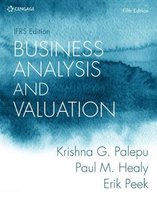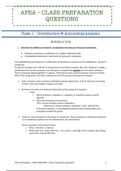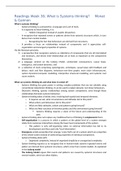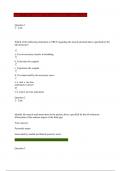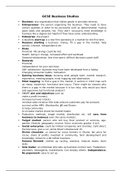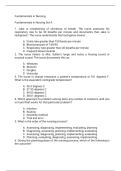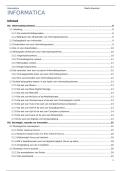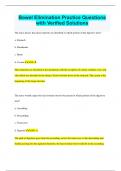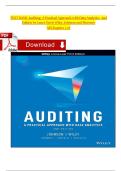AFSA – CLASS PREPARATION
QUESTIONS
Class 1 – Introduction & Accounting analysis
INTRODUCTION
1. Describe the difference between consolidated and statutory financial statements.
• Statutory statements: statements of 1 single traditional entity
• Consolidated statements: statements of a group of companies
Consolidated financial statement: Combination of the parent company and its subsidiaries = group of
companies
If a parent company owns 50+1% of voting shares of another company, then this company is called a
subsidiary of the parent company, thus the parent company has control over this other company.
These companies belong together in a group. If the parent owns another business, but for less than
50% of the voting stock, the other company is not in the group of the parent company.
• Each company makes statutory individual financial statements, most of the times according
to their local rules (single company accounts)
• But there also has to be financial statements of the group of companies
o How?
§ Parent company, subsidiary 1, subsidiary 2 ( add their balance sheets
together
§ Eliminate intra group transactions
à Ex. parent company sells to subsidiary 1
o Revenue in parent company, subsidiary 1 cost, subtract this
à Another example, a consolidated statement only contains debt from
companies outside the group
• Taxes are not accounted on the group of companies, they are based on individual companies
so consolidated numbers are not influenced by tax motivations!
Some synonyms in the balance sheet:
o Sales = turnover = revenue
o Result after tax = profit after tax = net income = earnings of the company (we always
work with result AFTER TAX)
Lotte Vermaerke – AFSA 2019-2020 – Class Preparation Questions 1
, 2. Nichols and Wahlen (2004) examine the efficiency with which the capital markets impound
quarterly earnings information into share prices and conclude that the “post- earnings-
announcement drift results of Bernard and Thomas (1989) extend to recent data” (Nichols
and Wahlen 2004, p. 263). What does this mean? Based on this result, what does this result
imply (1) for market efficiency and (2) financial statement analysis?
Unexpected earnings = Real earnings – expected earnings
(analysts make a forecast of earnings they expect to be
announced)
Vertical line is day of announcement, every company is one
horizontal “line”. The researchers went back in time and
computed unexpected earnings: earnings that are actually
announced – the expected earnings.
The researchers divided the firms into percentiles, the
highest line on the left side of the graph are the firms with
the highest unexpected earnings.
Rank companies
• Good news company = companies who report earnings higher than expected
• Bad news company = companies who report earnings lower than expected
Good news: companies have returns higher than the market index à so it looks that the market
already knows which companies are going to give good or bad news.
Cumulative abnormal return: you add all the abnormal returns from 60 days prior to announcement
until the announcement (cumulative thats why the line gets higher and higher)
60 days later = post earnings announcements = drift
So, companies who announce good news: after the announcement their shares still rise = drift (right
part)
à The companies who will say they have a very positive unexpected earning, their companies will
perform very good in the 60 days before the announcement of the unexpected earnings. Is that
consistent with the markets? Is that evidence of efficient markets? YES! The market reacts quickly to
accounting information and foresees what there is going to happen. The share prices at the moment
of earnings announcement date are already impacted by good or bad news. The markets react
quickly because there are already leaks of information à markets are efficient
à But is it completely? No, even after the announcement, the numbers become better; it still
evolves 60 days after earnings announcement = post-earnings-announcement drift à The market is
efficient but not completely
à Conclusion: the market is efficient but not fully efficient. It impounds a big part of the
information (but not completely => post earnings announcement drift)
• So, it’s possible to make gains with FSA because the market is not fully efficient: analysis of
historic accounting information is relevant!
• But even in a fully efficient market it is possible because individual firms’ valuation can be
mispriced
à Problems with the suppliers for example is a sign of bad news
Companies react to news
• Europe: show earnings announcements every 6 months
• America: every 3 months
Lotte Vermaerke – AFSA 2019-2020 – Class Preparation Questions 2
, 3. The textbook describes four key steps in analyzing a business using financial statements.
What are those steps and what is the importance of each one of these steps for business
analysis?
1. Business strategy analysis
Purpose of BSA is to identify key profit drivers and business risks. It involves identifying the
industry and its strategy to create a sustainable competitive advantage. Identification of key
success factors and key business risks allows the identification of key accounting policies.
There are different kind of strategies (low cost – differentiation). This is important because
you want to know what you have to evaluate. Depending on de strategy, there will be different
kind of success factors. For differentiation this is large profit margin (earnings over sales). If
the company doesn’t have those, it does not succeed in his strategy. Low cost companies
normally have small profit margins.
à A company develops a strategy to survive in the industry: we have to know what the KPI’s
are for each business strategy, and those depend on the strategy.
o In which industry is a company situated?
o What is their strategy to compete with the others?
o Product differentiation
à High profit margin or low asset turnover
à P.e. Porsche (high profit) vs Volkswagen: less volume sold, but at
higher prices
o Low cost
à Low profit margin or high asset turnover
!"# %&'()#*
à Profit margin = *+,"*
-+,"*
à Asset turnover = .'#+, +**"#* è many Volkswagens are sold
à ROA = profit margin x asset turnover
à BSA facilitates evaluating whether current profitability is sustainable and it enables the
analyst to make sound assumptions in forecasting a firm’s future performance.
2. Accounting analysis
A critical look at the financial statements. Even the accounting standards themselves can cause
that the numbers in the financial statements does not reflect the underlying reality of the
business.
The purpose here is to evaluate the degree to which a firm’s accounting captures the
underlying business reality. Are there distortions? (bv. in depreciation)
à Look critically: It’s not because a firm has a lot of liabilities, that a firm has a lot of
obligations!
Lotte Vermaerke – AFSA 2019-2020 – Class Preparation Questions 3
QUESTIONS
Class 1 – Introduction & Accounting analysis
INTRODUCTION
1. Describe the difference between consolidated and statutory financial statements.
• Statutory statements: statements of 1 single traditional entity
• Consolidated statements: statements of a group of companies
Consolidated financial statement: Combination of the parent company and its subsidiaries = group of
companies
If a parent company owns 50+1% of voting shares of another company, then this company is called a
subsidiary of the parent company, thus the parent company has control over this other company.
These companies belong together in a group. If the parent owns another business, but for less than
50% of the voting stock, the other company is not in the group of the parent company.
• Each company makes statutory individual financial statements, most of the times according
to their local rules (single company accounts)
• But there also has to be financial statements of the group of companies
o How?
§ Parent company, subsidiary 1, subsidiary 2 ( add their balance sheets
together
§ Eliminate intra group transactions
à Ex. parent company sells to subsidiary 1
o Revenue in parent company, subsidiary 1 cost, subtract this
à Another example, a consolidated statement only contains debt from
companies outside the group
• Taxes are not accounted on the group of companies, they are based on individual companies
so consolidated numbers are not influenced by tax motivations!
Some synonyms in the balance sheet:
o Sales = turnover = revenue
o Result after tax = profit after tax = net income = earnings of the company (we always
work with result AFTER TAX)
Lotte Vermaerke – AFSA 2019-2020 – Class Preparation Questions 1
, 2. Nichols and Wahlen (2004) examine the efficiency with which the capital markets impound
quarterly earnings information into share prices and conclude that the “post- earnings-
announcement drift results of Bernard and Thomas (1989) extend to recent data” (Nichols
and Wahlen 2004, p. 263). What does this mean? Based on this result, what does this result
imply (1) for market efficiency and (2) financial statement analysis?
Unexpected earnings = Real earnings – expected earnings
(analysts make a forecast of earnings they expect to be
announced)
Vertical line is day of announcement, every company is one
horizontal “line”. The researchers went back in time and
computed unexpected earnings: earnings that are actually
announced – the expected earnings.
The researchers divided the firms into percentiles, the
highest line on the left side of the graph are the firms with
the highest unexpected earnings.
Rank companies
• Good news company = companies who report earnings higher than expected
• Bad news company = companies who report earnings lower than expected
Good news: companies have returns higher than the market index à so it looks that the market
already knows which companies are going to give good or bad news.
Cumulative abnormal return: you add all the abnormal returns from 60 days prior to announcement
until the announcement (cumulative thats why the line gets higher and higher)
60 days later = post earnings announcements = drift
So, companies who announce good news: after the announcement their shares still rise = drift (right
part)
à The companies who will say they have a very positive unexpected earning, their companies will
perform very good in the 60 days before the announcement of the unexpected earnings. Is that
consistent with the markets? Is that evidence of efficient markets? YES! The market reacts quickly to
accounting information and foresees what there is going to happen. The share prices at the moment
of earnings announcement date are already impacted by good or bad news. The markets react
quickly because there are already leaks of information à markets are efficient
à But is it completely? No, even after the announcement, the numbers become better; it still
evolves 60 days after earnings announcement = post-earnings-announcement drift à The market is
efficient but not completely
à Conclusion: the market is efficient but not fully efficient. It impounds a big part of the
information (but not completely => post earnings announcement drift)
• So, it’s possible to make gains with FSA because the market is not fully efficient: analysis of
historic accounting information is relevant!
• But even in a fully efficient market it is possible because individual firms’ valuation can be
mispriced
à Problems with the suppliers for example is a sign of bad news
Companies react to news
• Europe: show earnings announcements every 6 months
• America: every 3 months
Lotte Vermaerke – AFSA 2019-2020 – Class Preparation Questions 2
, 3. The textbook describes four key steps in analyzing a business using financial statements.
What are those steps and what is the importance of each one of these steps for business
analysis?
1. Business strategy analysis
Purpose of BSA is to identify key profit drivers and business risks. It involves identifying the
industry and its strategy to create a sustainable competitive advantage. Identification of key
success factors and key business risks allows the identification of key accounting policies.
There are different kind of strategies (low cost – differentiation). This is important because
you want to know what you have to evaluate. Depending on de strategy, there will be different
kind of success factors. For differentiation this is large profit margin (earnings over sales). If
the company doesn’t have those, it does not succeed in his strategy. Low cost companies
normally have small profit margins.
à A company develops a strategy to survive in the industry: we have to know what the KPI’s
are for each business strategy, and those depend on the strategy.
o In which industry is a company situated?
o What is their strategy to compete with the others?
o Product differentiation
à High profit margin or low asset turnover
à P.e. Porsche (high profit) vs Volkswagen: less volume sold, but at
higher prices
o Low cost
à Low profit margin or high asset turnover
!"# %&'()#*
à Profit margin = *+,"*
-+,"*
à Asset turnover = .'#+, +**"#* è many Volkswagens are sold
à ROA = profit margin x asset turnover
à BSA facilitates evaluating whether current profitability is sustainable and it enables the
analyst to make sound assumptions in forecasting a firm’s future performance.
2. Accounting analysis
A critical look at the financial statements. Even the accounting standards themselves can cause
that the numbers in the financial statements does not reflect the underlying reality of the
business.
The purpose here is to evaluate the degree to which a firm’s accounting captures the
underlying business reality. Are there distortions? (bv. in depreciation)
à Look critically: It’s not because a firm has a lot of liabilities, that a firm has a lot of
obligations!
Lotte Vermaerke – AFSA 2019-2020 – Class Preparation Questions 3

